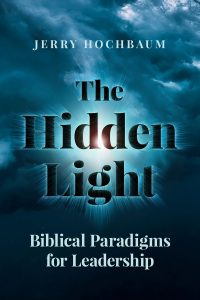Excerpted from The Hidden Light: Biblical Paradigms of Leadership by Dr. Jerry Hochbaum, co-published by OU Press and KTAV
 The Leader and His Progeny: Never One Size in Education
The Leader and His Progeny: Never One Size in Education
Parashat Toldot deals essentially with the genesis of the profound enmity between Ya’akov and Eisav, one that pervades Jewish history until this day. How can we explain the root cause of this most troublesome phenomenon, considering that Eisav is also the son of Yitzḥak and Rivkah, our second patriarch and matriarch?
There is much discussion among the commentaries regarding the twin brothers’ childhood. Rabbi Samson Raphael Hirsch poses an unusual and radical solution that deserves our attention because it may have relevance for our time as well.
The Torah tells us, “vayigdelu hane’arim,” Ya’akov and Eisav matured. “Vayehi Eisav ish yode’a tzayid, ish sadeh,” Eisav becomes a hunter, a man of the field, one comfortable in the wider society whose values differ substantially from the moral climate of Yitzḥak and Rivkah’s household. A hunter is not a desired Jewish profession, then or now. Ya’akov, on the other hand, is described as “ish tam, yoshev ohalim,” a tent dweller, a pious, insular scholar engaged in Torah studies.
According to Rabbi Hirsch, this divergence in character between the two brothers surfaces only after they mature. That is explicit in the preceding verse. Until that time, according to Rabbi Hirsch and others, they were raised in the same home, exposed to the same socialization by their parents, attended the same schools, and were enveloped in the same moral and spiritual ambience that their parents represented. So what was responsible for the very radically divergent paths of their lives?
The Torah, Rabbi Hirsch points out, characteristically does not cover up the blemishes of our ancestors. We must learn from their noble achievements, but from their errors as well. What occurred here was a failure of adhering to the principle, “ḥanokh lana’ar al pi darko.” Parents are responsible for educating their children by taking into account their special needs and predispositions.
Eisav, like Ya’akov, has his own set of predilections and strengths on which his upbringing should have been based. There is no one formula or recipe for educating all children, even the offspring of Yitzḥak and Rivkah. That he was not schooled and socialized in a more individualized way might have contributed to Eisav’s unacceptable behavior and activities.
This knowledge and insight did indeed have an important impact on Ya’akov himself. At the end of his life he gathers together his sons, the twelve tribes of Israel, for his final message and blessing to them. The Torah describes his blessing in the following words: “Ish asher k’virkhato berakh otam.” Ya’akov blesses all of them “in accordance with their blessing.” In other words, he recognizes that each of them has unique aptitudes and talents. One general blessing for all would not suffice. Ya’akov is able to identify the special potential of each son, and shape his blessings to address and fully express that individual trait or characteristic.
His blessings range far and wide – from success in business and agriculture to moral, political, and spiritual leadership. By highlighting and praying for each son’s individual success in the area of his greatest talents and aptitudes, he ensures that the Jewish people would also be blessed as a collective.
The gap that Rabbi Hirsch wisely identifies regarding Eisav’s education has certainly affected our history, as the Toldot narrative reveals. The leadership of the Jewish community, and especially parents raising the next generation of Jews, needs to be continually conscious of the critical omission identified by Rabbi Hirsch.
There is ample evidence that some Jewish leaders, parents, and educators are still not devising and tailoring their children’s education to the special needs, interests, and character of their children and students. Rabbi Hirsch’s stunning insight thus has equal relevance in our age.

